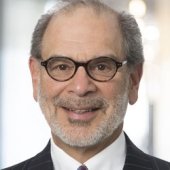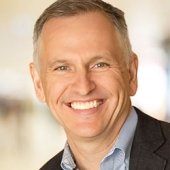Economist Peter Henry offers a roadmap for a more equitable and prosperous future
IN BRIEF
- "Somewhat disappointingly, I don’t think that first-world countries have made a lot of progress on what I would call the structural policy fronts."
- "If the rate of return on investing in a road in Zambia is higher than the rate of return on S&P 500, there ought to be some folks in the US who are trying to figure out a way to invest in roads in Zambia."
- "I don’t think crypto will be a major factor in how central banks are thinking about monetary policy. I suspect that digital currencies are going to be more important than crypto. It’s hard to see a world in which central banks give up the role of being the creators of fiat money."
In this video interview, Joe Kornik, Editor-in Chief of VISION by Protiviti, talks with Dr. Peter Henry, an economist, Protiviti Advisory Board member, and Senior Fellow at Stanford’s Hoover Institute and Freeman Spogli Institute for International Studies, about the future of money, specifically what could lead us to a more equitable and prosperous future.
In this interview:
1:40 - What did we learn in the last 10 years?
6:25 - The prospects of the global inflation
10:20 - Global macroeconomic assessment and opportunities
13:29 - Central banks and digital currency
17:15 - Advice for business leaders: Diversification and resilience
20:10 - The world in 2050
Economist Peter Henry offers a roadmap for a more equitable and prosperous future
Joe Kornik: Welcome to the VISION by Protiviti Interview. I’m Joe Kornik, Editor-in-Chief of VISION by Protiviti, a global content resource examining big themes that will impact the C-suite and executive board rooms worldwide. Today, we’re exploring the future of money, and I couldn’t be happier to welcome in Dr. Peter Henry, Protiviti board member, senior fellow at Stanford University’s Hoover Institution, senior fellow at Standford’s Freeman Spogli Institute for International Studies, and dean emeritus of NYU Stern School of Business. He is also the author of the very important and influential book Turnaround: Third-World Lessons for First-World Growth. Peter, thank you so much for joining me today.
Peter Henry: Great to be with you, Joe. Thank you for having me on.
Joe Kornik: Peter, it’s hard to believe it’s been 10 years since your book was published. In it, you talk about the significant progress developing countries had made and how first-world nations were in crisis, and in fact, we’re being held up largely by those emerging economies. It seems like a lot of the problems you were talking about a decade ago—income inequality, climate, hyperinflation, political uncertainty—are even greater challenges today. We’ve also witnessed developments no one would have predicted 10 years ago, financial setbacks in some of the emerging economies due to COVID, and the adoption of cryptocurrency in some developing economies to offset devaluing fiat currencies and provide a hedge to political instability. I’m curious, if you wrote a sequel to Turnaround today, what would you say are the lessons from the last 10 years and how do they shape your view of the future?
Peter Henry: Thank you for the question, Joe. It’s a great question and it is the right question. I think, when I look back, I think that what I would say is that policies really matter. Policy decisions that are made by our leaders have a dramatic impact for the lives of everyday people. That’s true in both first-world countries as well as third-world countries. In Turnaround, I was making the point that the way forward for first-world countries back in 2013, in a positive way, would look a lot like the policy recommendations that the first world had made for the third world back in the 1970s and 1980s.
What have we seen? Somewhat disappointingly, I don’t think that first-world countries have made a lot of progress on what I would call the structural policy fronts. What do I mean by that? In the aftermath of the global financial crisis, we had this narrative of central bankers as heroes. Ben Bernanke did a tremendous job of creating—and the Federal Reserve more broadly—of creating new financial instruments, quantitative easing, and so forth, that really helped us cope with the dramatic financial crisis. But then I think what happened is that the structural changes—so things like addressing educational policy, things like focusing on reforming immigration laws in the United States, right, because we need—think about it, in order for economy to grow, we need capital, labor, and ideas. Okay. If you want to grow, you need to grow the labor force, and we know that we got an aging population and we haven’t dealt in a systemic way with our need for more skilled foreign workers in particular. So we’ve not made a lot of progress on that front. Consequently, we’ve had slowing productivity.
This is not just a US-specific story. It’s a developed, first-world country story. Europe hasn’t made much progress on these issues either. Their population is aging even more rapidly than ours. In the absence of addressing what I would call these structural issues—and I haven’t even mentioned yet the challenges of Brexit, because I’m going to say, in addition to learning that policies really matter, the second lesson, which I’ll come to in a second, is that politics matter, at least as much as policies, because the politics really drive whether policies get through. But in the absence of these structural economic reforms that we needed to see in advanced economies to continue driving productivity growth so standards of living can continue to rise, we just had central bankers doing more and more to lower interest rates, keep interest rates low, and the debate was all around how low can they stay for how long, how long can quantitative easing continue. While all this was happening, our elected officials, both in the United States and abroad, didn’t really do very much to address these underlying structural issues that are really at the heart of what drives an economy: innovation, policies to encourage capital accumulation, and the free movement of labor, particularly getting more high-skilled labor into economies like the United States that really need it.
If you think about, for instance, the inflation challenges we’re dealing with right now, one of the issues is that the demand for goods and services is outstripping the supply of goods and services. What determines the supply of goods and services? Well, a really important factor that is the quantity of labor. We know there’s a labor shortage. That gets down to, again, immigration and education to create ways to help us have a greater labor supply. Those are some of the policies, and of course, as well, the inflation challenges we’re dealing with. Emerging economies, we’re dealing with those issues front and center in the 70s and 80s and we learned that if you want to keep inflation low, you need to keep interest rates at a reasonable level and manage fiscal policy. Of course, we’ve had large and growing deficits, large expansion of the money supply coupled with some shocks, the war in Ukraine, spiking food prices, and we’re struggling to get inflation down to a 2% target.
Joe Kornik: Right. Inflation is the elephant in the room. It continues to cause a drag globally. The US at least has made some progress with inflation but still has some way to go for sure.
Peter Henry: One of the really important lessons that I think we also have not learned in the advanced world, for emerging economies, is how to deal with inflation, in the following sense. If you go back to 2022 when inflation hit its peak, it was almost 10% in the United States and it was above 10% in both the UK and the European Union. That’s what we would call, by historical standards, if you also look at emerging economies, moderate inflation, because we have double-digit inflation that’s not as high as 40% but above single-digit inflation. We haven’t seen that kind of inflation in advanced economies since the 70s.
There’s been an expectation that the Fed, the ECB, and the Bank of England were going to be able to bring down moderate inflation, rapidly get back down to the 2% target, and engineer a so-called soft landing. Well, I think people overestimated how easy that was going to be because they ignored a rich history of developing countries trying to reduce moderate inflation. Yes, some developing countries have had hyperinflation, like Argentina and Brazil, but there are at least 56 episodes between 1976 and 1994 in emerging economies of countries that had inflation that were double digit, not 40% but 15% or so, that tried to reduce moderate inflation. What you learn from looking at those 56 historical episodes, reducing moderate inflation to low single-digit inflation is very, very hard. It typically fails because it’s so hard to do. It typically takes about three years or so, and you look at the historical record for countries to do that. If we learned that lesson, I think that we’d be having a slightly different view of how costly and how long it was going to take to reduce inflation.
If you look at England right now, or the UK, they’re looking more and more like an emerging economy frankly, with their debt problems and their inflation problem really not looking like it’s going to come down where they want anytime soon. The European Union is already in recession, so odds of a soft landing there are looking tough. The US may still make it, but we’ve got core inflation still running at 4.8% with a target of 2%, and very importantly, everyone’s asking how high rates have to go and how long do they have to stay in order for us to get down to 2%, but nobody is asking the question how rapidly do we need to get down to 2%? If you look at a country like Chile in 1992 when they first announced their inflation target, they made a decision that they were going to—they were coming down from inflation around 20%, and they eventually got down to single-digit inflation, but they did it very gradually over a course of several years. I’ve not heard in the current policy debate clarity from the Fed about how much of a hurry are we in to get to that 2%? Because that actually really makes a difference in terms of the impact on the economy of getting to 2%. If you try to go really rapidly, then the risk of a hard landing is greater.
Joe Kornik: When you look at the next two, three, five years, from a macroeconomic standpoint, from a global economy, what shape do you think we’re in? How optimistic are you or how concerned should we be?
Peter Henry: The thing that gives me optimism is the dynamism and the population growth that we see in the emerging world, so sub-Saharan Africa in particular. Right? The rich world is aging, much of the emerging world, sub-Saharan Africa in particular, has a rapidly growing young population. Those are lots of potentially productive workers to help living standards continue to rise. Now the challenge there, of course, is that those workers in emerging economies are working with a deficiency of capital, so specifically, think about infrastructure. Okay. There a billion people in the world without access to electricity and another billion people who don’t live within 5 kilometers of an all-season road or a road that functions all year round. The vast majority of those people actually live in sub-Saharan Africa where the population is growing most rapidly.
What we have to do is figure out how to do a better job of having the global financial system find a way to allocate capital to those kinds of infrastructure projects that can generate economic growth. For instance, if a $1.00 invested in infrastructure in Zambia can generate $1.40 of GDP, that’s a 40% return. Right? There are reasons to believe that the rate of return on infrastructure is that high in some places in the world. I’ve done the research on it. I come up with this idea called the dual hurdle framework, which basically says if the rate of return on investing in a road in Zambia is higher than the rate of return on private capital in Zambia, then the Zambian government should want to invest in roads.
Similarly, if the rate of return on investing in a road in Zambia is higher than the rate of return on S&P 500, there ought to be some folks in the US who are trying to figure out a way to invest in roads in Zambia. In other words, if investing in infrastructure in emerging markets clears both of those hurdles, then that’s a win-win. It’s a win for Zambia because investing in Zambian roads generates more GDP and jobs for their citizens, which reduces overall immigration pressure, people want to move out of that country, but it also generates returns for asset holders in rich countries where growth is slow and the population is aging.
I’m optimistic because we’ve got tremendous population growth in the emerging world, but in order for that optimism to actually turn into a reality of higher global growth for everybody and higher asset returns in the United States and elsewhere in the rich world, we’ve got to figure out this capital allocation problem, and I think the dual hurdle framework could help us do that.
Joe Kornik: Right. I’m wondering how, just the future of money per se, the rise of cryptos, the rise of digital currencies, I think most people are in agreement that those certainly will be the wave of the future, and specifically how central banks manage monetary policy around—with the emergence of cryptos and digital currencies. How do you see that playing out and what could that mean for the economy? I mean, could there be a leveling effect from a global standpoint, from an equitable standpoint?
Peter Henry: I think it’s very exciting to talk about shiny, new things. Cryptocurrency and digital currency certainly fall in that category. I think it’s important, when thinking about where we are, to use a baseball analogy, we’re probably somewhere in the first inning, if not – I think we’re maybe past the world’s but we’re still in the first inning. What I mean by that, well, just think about order of magnitude, the value of money, broadly speaking, in circulation in the global economy is probably, it’s upwards of $100 trillion in US dollar terms. The value of crypto is probably $1 trillion. When you’re thinking about macroeconomic policy right now, I don’t think this is a major factor in how central banks are thinking about how they’re dealing with monetary policy. Having said that, of course, central banks have many jobs, one of which is to think about what role these currencies may play in the future. I suspect that digital currencies are going to be more important than crypto. It’s hard to see a world in which central banks are going to give up the role of basically being the creators of fiat money. Right? They’ve done that historically through paper money, let’s call it. They have been increasingly already doing that to some extent through digital currency by default. I don’t see a world in which central banks are not playing a major role.
The basic role of the central bank is making sure that we don’t have too much money in circulation, whether it’s digital or paper or some combination of those things, relative to the supply of goods and services, that role is not going to change. But central banks will have interesting things to think about. Right? I don’t see the dichotomy being so much first versus third world as it's going to be thinking about, well, in a world in which the central bank can issue digital currency, how do we think about the transmission of monetary policy, the role of banks for instance in open market operations? Right? Traditionally, banks and financial institutions, major financial institutions, played a major role in the conduct of open market operations. But in a world of digital currency, one could think about, “Well, why does it all have to get integrated into the banks? Can’t we let households participate directly in some of these things?”
So it’s the first inning, lots of important questions, but the reality that we now will have, I think, different means by which this principal monetary policy could get conducted, different mechanisms, may raise some interesting questions about the democracy, how flat the system is in terms of the way monetary policy is implemented. I don’t pretend to have the answers to those questions, but central banks, trust me, are thinking about these issues, or should be thinking about these issues.
Joe Kornik: Peter, any advice you’d offer for business leaders, C-suite executives, directors, boards, as they try to look out and navigate the next decade, let’s say?
Peter Henry: Yes, I think it’s important to remember, what is the role of a leader? Role of a leader is to define reality and give hope. Okay. What’s the reality? The reality is, coming out of COVID, there’s a lot of talk of deglobalization. Global trade, in the context of a stable macroenvironment—which we can’t take for granted as we now see with the inflation rounds we’re dealing with—but global trade, assuming central banks do their job and return us to low, stable, predictable inflation, global trade in that environment is probably the single biggest policy driver of prosperity. We need more global trade, not less. The idea then of deglobalization I think is overwrought, although there certainly was a reaction in the aftermath of COVID.
I think the right way to think about global trade in the aftermath of COVID is we need, in addition to the efficient distribution of supply chains and labor and capital in lots of different places around the world, which raises productivity, when you think about more resilient supply chains, right? There’s a trade-off between efficiency and resilience, meaning, as leaders think about how to build their supply chains to deliver goods and services at lower cost, they’ve also got to think about diversification, and we’re already seeing some of that, right, diversification in places like Vietnam is now booming. India has great promise, right, as do other parts in South Asia. I talked previously about sub-Saharan Africa. Right? We need more global trade, not less, and so leaders need to think very hard about, “Okay. How do we deliver for our organizations in an environment where we know that 10 years from now, 20 years from now, we’re going to need more global trade, not less? How do we advocate for the right kinds of policies in our countries to make sure that we actually do see the kinds of changes that are needed in order to ensure that we get infrastructure, right, in places that have booming populations like sub-Saharan Africa?” Because these will be the growth centers of the future. Right? Why should business leaders care about these things? Well, because that’s where the population growth is and that’s where the potential GDP growth is higher.
Joe Kornik: Right. Well, you’ve given us a lot to think about here today. My last question is just you’ve laid out a very intriguing roadmap for the future, and I just wonder if we could take that roadmap and extend it out maybe two decades, a generation even. What’s possible if we do this right? What kind of world could we be living in 2040s or even 2050?
Peter Henry: Yes. I love the question. We could be living in a world where there’s substantially less poverty. We’ll still have to deal with income distribution. Human beings have a tendency to ask, “I’ve got a good life for my family. Your life for your family is even better than my life,” so we got to figure out how to manage that challenge, and that’s an age-old challenge that goes all the way back to the Ten Commandments and not being envious of what your neighbor has. Those problems of human nature are a lot easier to solve when everyone has a lot more. So, there’s the potential to have a greener planet with far less poverty and far more dignity for more human beings and an even more prosperous world. [Music]
Joe Kornik: Right. Well, that sounds like the kind of place we would all like to end up for sure. Peter, thank you so much for your time today. I really appreciate it.
Peter Henry: Thank you, Joe. I enjoyed the conversation.
Joe Kornik: Yes, I did as well. I really enjoyed those insights. Thank you for watching the VISION by Protiviti Interview. On behalf of Dr. Peter Henry, I’m Joe Kornik. We’ll see you next time.
Did you enjoy this content? For more like this, subscribe to the VISION by Protiviti newsletter.




























